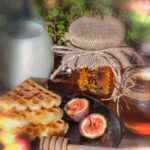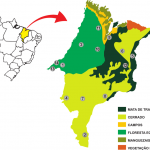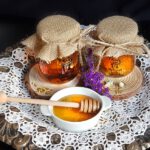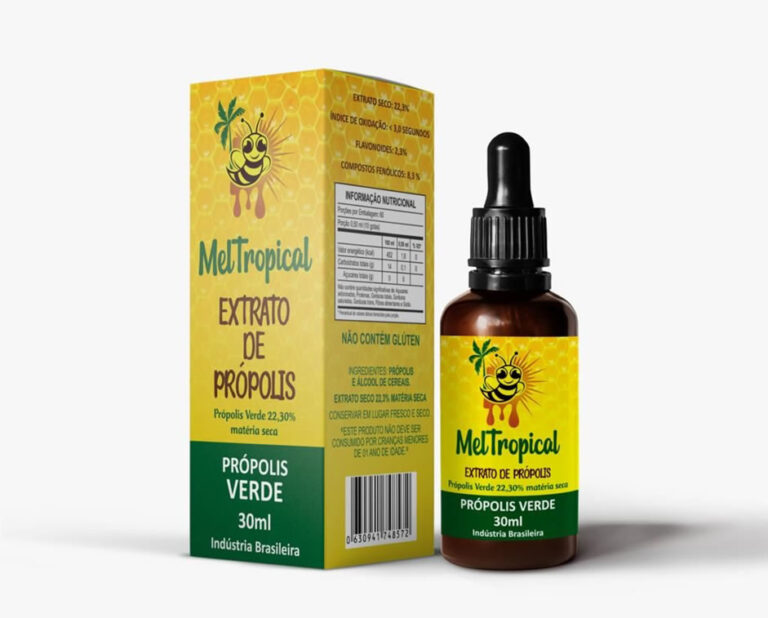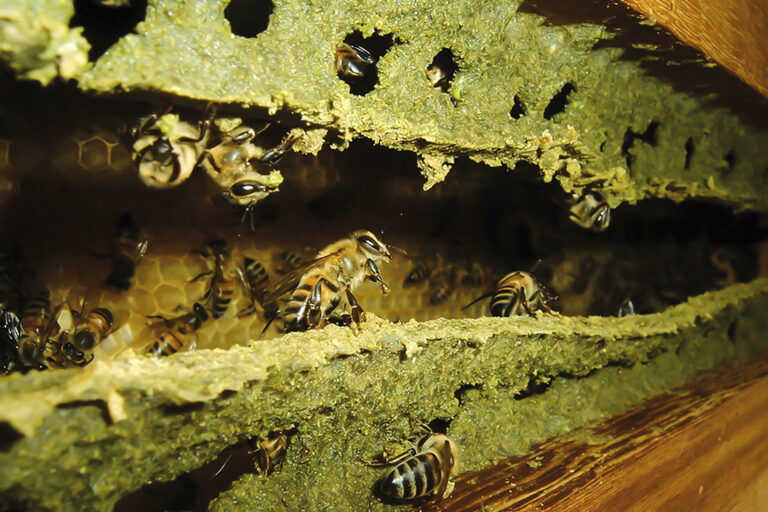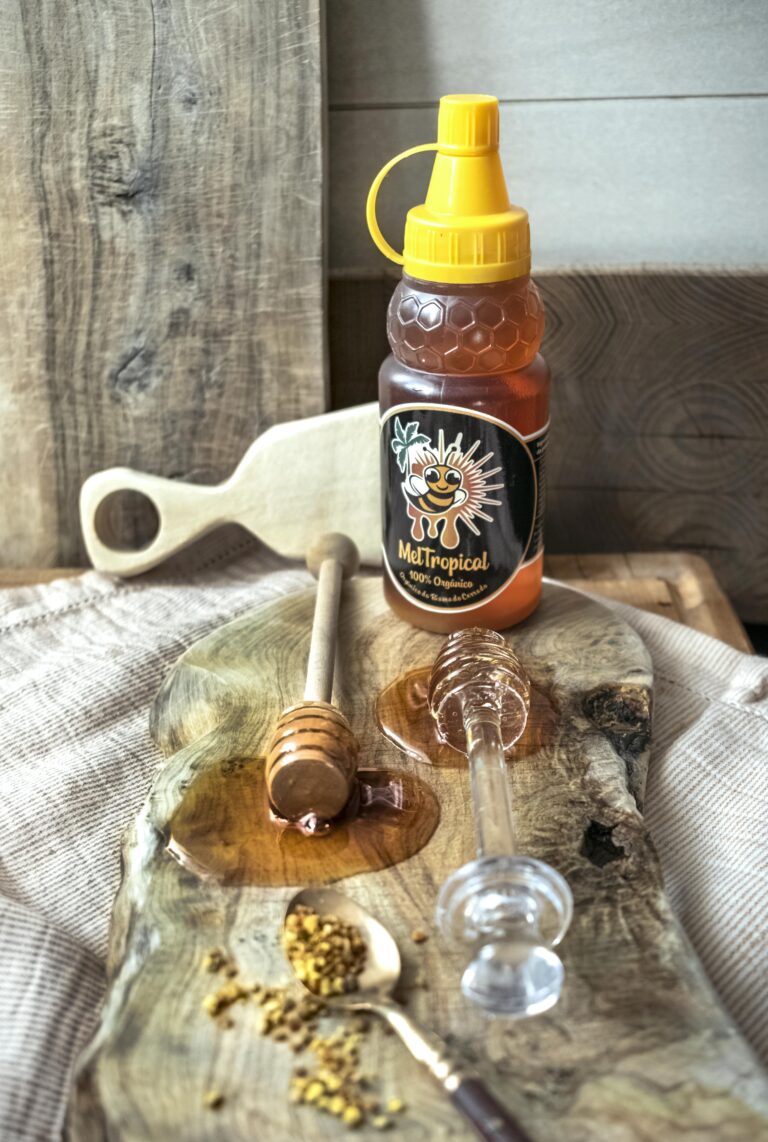
Cerrado, wildflower (polyfloral) honey
R$28.80 – R$38.80
Predominant with Croton sonderianus Muell. Arg. – Marmeleiro, Spermacoce verticillata L – White head broom , Mimosa pudica L – Touch me not, and Ipomea – Morning glory.
-
Predominant with Croton sonderianus Muell. Arg. – Marmeleiro, Spermacoce verticillata L – White head broom , Mimosa pudica L – Touch me not, and Ipomea – Morning glory.
Cerrado ( savannah ) honey….Honey from the biggest world garden , state of Maranhao , Northeast Region of Brazil……Best of the best… Made with pure organic Cerrado ( Brasilian savannah ) herbs just for you!!…… Feel the Brazil , taste the soul of Cerrado , unique place on the planet with over 10000 different plant species!!
Overview:
This is probably the most widespread, and at the same time the most common honey in Brazilian homes.
Brazilians simply adore this honey because with its irresistible and unique taste it forces consumers to empty the entire package of honey.
Be a Brazilian for at least a moment and indulge in enjoying this incredibly delicious honey.
Honey produced in the Cerrado is considered to be of superior organic quality.
Two factors contribute to this , specific climate and the local plants that give an optimal composition.
Many of our customers tried various honey from all regions of Brazil and most of them haven’t found anything like this.
Cerrado wild flower honey has a typical light to dark brown color with a lighter flavor than a conventional multifloral honey. It has smooth texture , stronger aroma , lighter flavor and is usually sweet.Color: typical light to dark brown
Aroma: stronger floral aroma
Taste: lighter flavor
Texture: smooth texture
Crystallization: very low crystallization speed, with fine crystals.
Geography: State of Maranhao , Northeast Brazil , Cerrado vegetation region
Floral Source:
The main plant families that our bees use as a flower resource for the production of Amazonian Cerrado multifloral honey are Leguminosae , Convolvulaceae , Anacardiaceae , Lamiaceae , Pedaliaceae plant family.
In the period between the rainy and dry seasons ( October to December ), the most important were Fabaceae, Euphorbiaceae, Malvaceae.
Pollen species showing the main persistence in the sample pollen during rainy flowering season ( January to June ) are Mimosa pudica L. ( Malicia ) , Ipomoea sp. ( Touch me not ) , Bixa orellana L. ( Lipstick tree ) also during the dry season ( July to December ) most common Cerrado pollen species are Spermacoce – Borreria verticilata (shrubby false buttonwood) , Mesosphaerum suaveolens (L.) Kuntze ( Bamburral ) , Spermacoce verticillata ( Vassourinha de botão )Production Season:
12 months . Wildflower honey is collected both in the rainy season and out of the rainy season, 1/3 of the honey plants from which meadow honey is formed have a flowering period during the rainy season (January to June), while 2/3 of the honey plants of the Amazon and northeastern Brazil bloom out of the rainy season ( from July to the end of December ).
Properties:
Our Cerrado honey is the richest and most complete food that is known and has great medicinal value.
The composition of pollen necessary to produce our honey is formed by 35% of proteins , 18 amino acids, 12 vitamins and 14 minerals.
This exquisite honey has antibiotic substances and growth accelerators, sex hormones, 30 to 35% protein, enzymes, phosphates, invertase and amylase, vitamins B1, B2, B3, B5, B6, B12, A, C, D, E, H and K.
Regarding minerals there is significant presence of : Calcium, Phosphorus, Iron, Copper, Zinc, Sodium, Magnesium, Manganese.
In addition to these nutrients this natural elixir contains also other active components such as flavonoid compounds .
Regular consumption of this product has a preventive effect on lowering cholesterol, which prevents the process of arteriosclerosis, it acts on the circulatory system, strengthens veins and arteries with beneficial action for people with heart problems, in addition to acting as an anti-inflammatory, antibiotic and antioxidant enzymes, hormones and nucleic acid, among other benefits.
It is also significant for prevention of anemia, brain aging, it strengthens vision and acts in the reduction of prostate growth, which affects around 60% of men over the age of 50, as it stimulates the production of testosterone – male sex hormone, responsible for the nutrition of the prostate and has no contraindication, can be consumed daily to keep the balance of the organism.
Honey plants from which honey is obtained in our Cerrado, is in the northeastern part of Brazil, bloom all year round, so we can offer our honey to our domestic and foreign market at any time, which is exactly the purest and highest quality honey that can be found in the market, both in Brazil and in the rest of the world.
Usage:Including the consumption of Cerrado honey in your daily life can make a big difference in your quality of life, since the product has numerous health benefits. Best of all, this is not difficult, as it is a very versatile ingredient and easy to incorporate! It can be used in desserts, meats, and also as a sweetener. So why don’t you consider using our Cerrado honey for breakfast , lunch , snack or a dinner?
Keeping our Cerrado polyfloral honey on hand is sure to be a good idea, no matter what type of cuisine you’re cooking. You know honey is great on a slice of bread with butter , our favorite combination is tapioca smeared with honey or in your breakfast cereals – muesli – granola , but it can do so much more!
Dosage , nutritional values and other important information about our honey
Max dosage of honey per day ( kids and adults )
Under 12 months: Do NOT give honey to this age group.
1 to 2 year-olds: max. 7 teaspoons (35 g) sugar , that is approximately 2 tablespoons (34 g) honey.
3 to 6 year-olds: max. 9 teaspoons (45 g) sugar , that is approximately 2 1/2 tablespoons (42.5 g) honey.
Over 6 years and adults: max. 11 teaspoons (55 g) sugar – approximately 3 tablespoons (51 g) honey ( a little over two tablespoons for women and three tablespoons for men )
The World Health Organization suggests that free sugars (which means all monosaccharides and disaccharides added to foods by the manufacturers, cooks, or during cooking at home, plus sugars naturally present in honey, syrups and fruit juices) make up no more than 10% of a person’s daily energy intake. The chemical energy contained in foods and drinks that can be metabolised to produce energy available to the body. For an adult requiring 2000 kcal a day, 10% equates to no more than 200 kcal from free sugars, which is about 60 grams of honey if honey is used as the unique external source of sugar in one’s diet.
Nutritional values
Average nutritional values * per 20 gr ( 1 tablespoon )
caloric value274 kJ / 64 kcal ( 3% )
Carbohydrates (including sugar) 16 gr ( 5 % )
Sodium 0,00 mg ( 0% )Important notice:
Real , 100% Pure , Natural , Raw or Raw Filtered Honey Crystallizes . And That’s A Good Thing.
LITTLE UNDERSTOOD. The CRYSTALLIZATION OF HONEY is little understood by the consuming public. Many assume that crystallized honey is adulterated or ‘spoiled.’ This is not so.
REAL, RAW HONEY CRYSTALLIZES .The crystallization process is natural and spontaneous. Pure, raw and unheated honey has a natural tendency to crystallize over time with no effect on the honey other than color and texture.
What’s more, the crystallization of honey actually preserves the flavor and quality characteristics of your honey. Many honey users prefer it in this state as it is easier to spread on bread or toast. Indeed, some raw honey recipes can be easier to make with partially or fully-crystallized honey.Crystallized honey also tastes richer. When the honey is in a crystallized state it takes longer to melt on your tongue, allowing all of your taste buds to activate and pick up on the subtleties.
Even if crystallized, it can be consumed normally, or heated in a water bath to 40ºC to return to its liquid state. It is important to be patient , take care not to heat it above 40ºC, as honey characteristics and properties can be compromised.
-
Description
Predominant with Croton sonderianus Muell. Arg. – Marmeleiro, Spermacoce verticillata L – White head broom , Mimosa pudica L – Touch me not, and Ipomea – Morning glory.
Cerrado ( savannah ) honey….Honey from the biggest world garden , state of Maranhao , Northeast Region of Brazil……Best of the best… Made with pure organic Cerrado ( Brasilian savannah ) herbs just for you!!…… Feel the Brazil , taste the soul of Cerrado , unique place on the planet with over 10000 different plant species!!
Overview:
This is probably the most widespread, and at the same time the most common honey in Brazilian homes.
Brazilians simply adore this honey because with its irresistible and unique taste it forces consumers to empty the entire package of honey.
Be a Brazilian for at least a moment and indulge in enjoying this incredibly delicious honey.
Honey produced in the Cerrado is considered to be of superior organic quality.
Two factors contribute to this , specific climate and the local plants that give an optimal composition.
Many of our customers tried various honey from all regions of Brazil and most of them haven’t found anything like this.
Cerrado wild flower honey has a typical light to dark brown color with a lighter flavor than a conventional multifloral honey. It has smooth texture , stronger aroma , lighter flavor and is usually sweet.Color: typical light to dark brown
Aroma: stronger floral aroma
Taste: lighter flavor
Texture: smooth texture
Crystallization: very low crystallization speed, with fine crystals.
Geography: State of Maranhao , Northeast Brazil , Cerrado vegetation region
Floral Source:
The main plant families that our bees use as a flower resource for the production of Amazonian Cerrado multifloral honey are Leguminosae , Convolvulaceae , Anacardiaceae , Lamiaceae , Pedaliaceae plant family.
In the period between the rainy and dry seasons ( October to December ), the most important were Fabaceae, Euphorbiaceae, Malvaceae.
Pollen species showing the main persistence in the sample pollen during rainy flowering season ( January to June ) are Mimosa pudica L. ( Malicia ) , Ipomoea sp. ( Touch me not ) , Bixa orellana L. ( Lipstick tree ) also during the dry season ( July to December ) most common Cerrado pollen species are Spermacoce – Borreria verticilata (shrubby false buttonwood) , Mesosphaerum suaveolens (L.) Kuntze ( Bamburral ) , Spermacoce verticillata ( Vassourinha de botão )Production Season:
12 months . Wildflower honey is collected both in the rainy season and out of the rainy season, 1/3 of the honey plants from which meadow honey is formed have a flowering period during the rainy season (January to June), while 2/3 of the honey plants of the Amazon and northeastern Brazil bloom out of the rainy season ( from July to the end of December ).
Properties:
Our Cerrado honey is the richest and most complete food that is known and has great medicinal value.
The composition of pollen necessary to produce our honey is formed by 35% of proteins , 18 amino acids, 12 vitamins and 14 minerals.
This exquisite honey has antibiotic substances and growth accelerators, sex hormones, 30 to 35% protein, enzymes, phosphates, invertase and amylase, vitamins B1, B2, B3, B5, B6, B12, A, C, D, E, H and K.
Regarding minerals there is significant presence of : Calcium, Phosphorus, Iron, Copper, Zinc, Sodium, Magnesium, Manganese.
In addition to these nutrients this natural elixir contains also other active components such as flavonoid compounds .
Regular consumption of this product has a preventive effect on lowering cholesterol, which prevents the process of arteriosclerosis, it acts on the circulatory system, strengthens veins and arteries with beneficial action for people with heart problems, in addition to acting as an anti-inflammatory, antibiotic and antioxidant enzymes, hormones and nucleic acid, among other benefits.
It is also significant for prevention of anemia, brain aging, it strengthens vision and acts in the reduction of prostate growth, which affects around 60% of men over the age of 50, as it stimulates the production of testosterone – male sex hormone, responsible for the nutrition of the prostate and has no contraindication, can be consumed daily to keep the balance of the organism.
Honey plants from which honey is obtained in our Cerrado, is in the northeastern part of Brazil, bloom all year round, so we can offer our honey to our domestic and foreign market at any time, which is exactly the purest and highest quality honey that can be found in the market, both in Brazil and in the rest of the world.
Usage:Including the consumption of Cerrado honey in your daily life can make a big difference in your quality of life, since the product has numerous health benefits. Best of all, this is not difficult, as it is a very versatile ingredient and easy to incorporate! It can be used in desserts, meats, and also as a sweetener. So why don’t you consider using our Cerrado honey for breakfast , lunch , snack or a dinner?
Keeping our Cerrado polyfloral honey on hand is sure to be a good idea, no matter what type of cuisine you’re cooking. You know honey is great on a slice of bread with butter , our favorite combination is tapioca smeared with honey or in your breakfast cereals – muesli – granola , but it can do so much more!
Dosage , nutritional values and other important information about our honey
Max dosage of honey per day ( kids and adults )
Under 12 months: Do NOT give honey to this age group.
1 to 2 year-olds: max. 7 teaspoons (35 g) sugar , that is approximately 2 tablespoons (34 g) honey.
3 to 6 year-olds: max. 9 teaspoons (45 g) sugar , that is approximately 2 1/2 tablespoons (42.5 g) honey.
Over 6 years and adults: max. 11 teaspoons (55 g) sugar – approximately 3 tablespoons (51 g) honey ( a little over two tablespoons for women and three tablespoons for men )
The World Health Organization suggests that free sugars (which means all monosaccharides and disaccharides added to foods by the manufacturers, cooks, or during cooking at home, plus sugars naturally present in honey, syrups and fruit juices) make up no more than 10% of a person’s daily energy intake. The chemical energy contained in foods and drinks that can be metabolised to produce energy available to the body. For an adult requiring 2000 kcal a day, 10% equates to no more than 200 kcal from free sugars, which is about 60 grams of honey if honey is used as the unique external source of sugar in one’s diet.
Nutritional values
Average nutritional values * per 20 gr ( 1 tablespoon )
caloric value274 kJ / 64 kcal ( 3% )
Carbohydrates (including sugar) 16 gr ( 5 % )
Sodium 0,00 mg ( 0% )Important notice:
Real , 100% Pure , Natural , Raw or Raw Filtered Honey Crystallizes . And That’s A Good Thing.
LITTLE UNDERSTOOD. The CRYSTALLIZATION OF HONEY is little understood by the consuming public. Many assume that crystallized honey is adulterated or ‘spoiled.’ This is not so.
REAL, RAW HONEY CRYSTALLIZES .The crystallization process is natural and spontaneous. Pure, raw and unheated honey has a natural tendency to crystallize over time with no effect on the honey other than color and texture.
What’s more, the crystallization of honey actually preserves the flavor and quality characteristics of your honey. Many honey users prefer it in this state as it is easier to spread on bread or toast. Indeed, some raw honey recipes can be easier to make with partially or fully-crystallized honey.Crystallized honey also tastes richer. When the honey is in a crystallized state it takes longer to melt on your tongue, allowing all of your taste buds to activate and pick up on the subtleties.
Even if crystallized, it can be consumed normally, or heated in a water bath to 40ºC to return to its liquid state. It is important to be patient , take care not to heat it above 40ºC, as honey characteristics and properties can be compromised.


